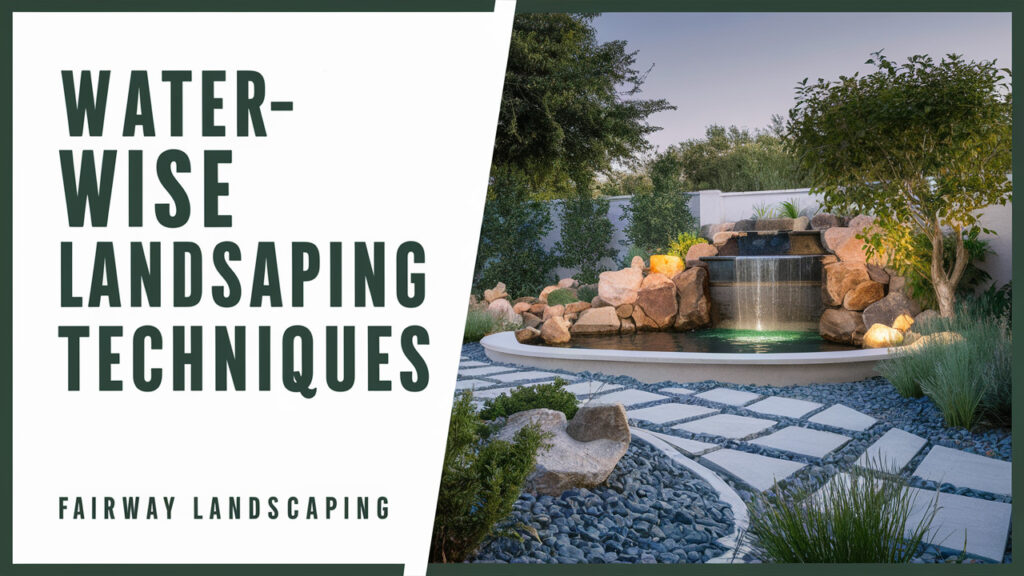Did you know that traditional landscaping can account for up to 70% of a household’s water usage? With increasing concerns about water scarcity and the need for conservation, it’s more important than ever to adopt water-wise landscaping techniques. By making strategic choices in plant selection, irrigation, and garden design, you can significantly reduce your water consumption while maintaining a beautiful and thriving landscape. This article will explore a variety of water-wise landscaping techniques to help you save water and create a more sustainable outdoor space.

Section 1: Choosing Drought-Tolerant Plants
Selecting Plants That Thrive in Dry Conditions
One of the most effective ways to reduce water usage in your landscape is to choose plants that are naturally adapted to dry conditions. Drought-tolerant plants have evolved to survive with minimal water, making them perfect for water-wise gardens. Some excellent options include:
- Succulents: These fleshy plants store water in their leaves and stems, allowing them to thrive in arid environments.
- Ornamental grasses: Many species of ornamental grasses are drought-resistant and add texture and movement to your landscape.
- Mediterranean herbs: Herbs like lavender, rosemary, and thyme are not only drought-tolerant but also add fragrance and culinary value to your garden.
When selecting drought-tolerant plants, consider their sunlight and soil requirements to ensure they thrive in your specific garden conditions. Learn more about creating a drought-resistant garden in our previous blog post: 10 Tips for a Drought-Resistant Garden.
Section 2: Efficient Irrigation Systems
Optimizing Your Irrigation for Water Efficiency
Efficient irrigation systems can significantly reduce water waste while ensuring your plants receive the moisture they need. Some water-wise irrigation options include:
- Drip irrigation: This system delivers water directly to the roots of your plants through a network of tubes and emitters, minimizing evaporation and runoff.
- Soaker hoses: These porous hoses release water slowly along their length, allowing water to seep directly into the soil around your plants.
- Smart irrigation controllers: These devices use weather data and soil moisture sensors to automatically adjust watering schedules based on actual plant needs.
When installing an efficient irrigation system, be sure to group plants with similar water requirements together and adjust watering schedules seasonally. Fairway Landscaping offers professional irrigation system installation and maintenance services to help you optimize your watering efficiency.
Section 3: Mulching for Moisture Retention
Using Mulch to Conserve Soil Moisture
Mulching is a simple yet effective way to conserve soil moisture and reduce water evaporation in your garden. By applying a layer of mulch around your plants, you can:
- Organic mulches: Materials like bark chips, straw, and shredded leaves break down over time, improving soil structure and fertility.
- Inorganic mulches: Materials like gravel and rubber mulch don’t decompose but can provide a decorative element to your landscape while retaining moisture.
Apply a 2-3 inch layer of mulch around your plants, keeping it a few inches away from plant stems to prevent rot. Replenish the mulch as needed to maintain its effectiveness. Read more about the benefits of mulching in our blog post: Why Mulching is a Must for Every Garden.
Section 4: Xeriscaping Principles
Implementing Xeriscaping in Your Garden
Xeriscaping is a comprehensive approach to water-wise landscaping that involves designing your garden to minimize water usage. Key principles of xeriscaping include:
- Zoning plants by water needs: Group plants with similar water requirements together to create efficient watering zones.
- Soil improvement: Amend your soil with organic matter to improve its water retention and drainage.
- Efficient irrigation: Use drip irrigation, soaker hoses, or other efficient watering methods to minimize water waste.
When designing a xeriscape garden, focus on creating a visually appealing landscape using drought-tolerant plants, mulches, and hardscaping elements like rocks and gravel. Fairway Landscaping offers xeriscape design and installation services to help you create a beautiful, water-wise garden.
Section 5: Rainwater Harvesting
Collecting and Using Rainwater in Your Garden
Rainwater harvesting involves collecting and storing rainwater for later use in your garden. By capturing rainwater, you can reduce your reliance on municipal water sources and provide your plants with naturally softened water. Some rainwater harvesting methods include:
- Rain barrels: These small containers collect rainwater from your roof’s downspout and store it for later use in your garden.
- Cisterns: Larger than rain barrels, cisterns can store substantial amounts of rainwater for irrigation purposes.
- Rain gardens: These shallow depressions in your landscape are designed to collect and absorb rainwater runoff, allowing it to percolate into the soil.
When setting up a rainwater harvesting system, ensure that it is properly sized for your garden’s needs and that the collected water is used within a reasonable timeframe to prevent stagnation. Learn more about rainwater harvesting techniques in our blog post: 5 Ways to Harvest Rainwater for Your Garden.
Conclusion
Implementing water-wise landscaping techniques is a smart way to conserve water, save money, and create a more sustainable outdoor space. By choosing drought-tolerant plants, installing efficient irrigation systems, mulching, adopting xeriscaping principles, and harvesting rainwater, you can significantly reduce your water usage while maintaining a beautiful and thriving garden.
If you’re interested in incorporating water-wise techniques into your landscape, contact Fairway Landscaping today at (443) 206-0221 or visit our contact page to schedule a consultation with our experienced team of landscaping professionals.
